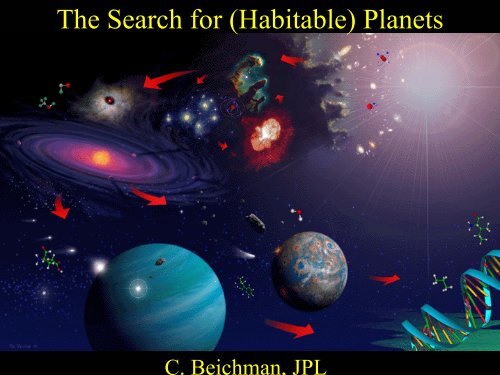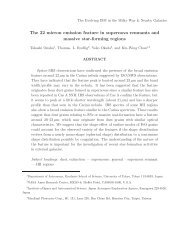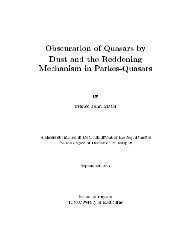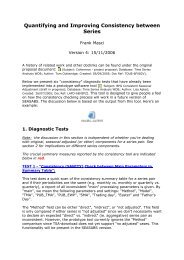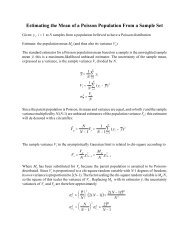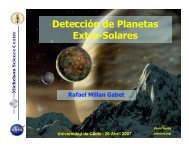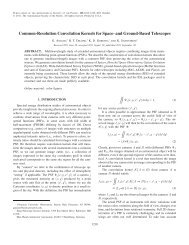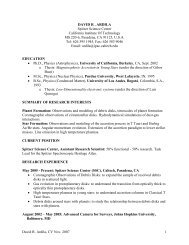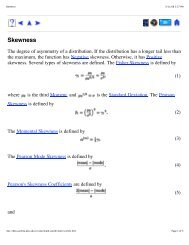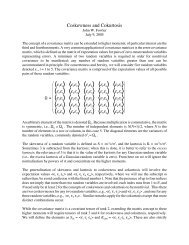Santa Cruz
Santa Cruz
Santa Cruz
You also want an ePaper? Increase the reach of your titles
YUMPU automatically turns print PDFs into web optimized ePapers that Google loves.
The Search for (Habitable) Planets<br />
C. Beichman, JPL
Fundamental Facts To Remember<br />
About the Search for Planets and Life<br />
• The necessary ingredients of life are widespread<br />
– Observation reveals uniformity of physical and chemical laws<br />
– Origin of the elements and their dispersal is well understood<br />
– Carbon bond is unique and ubiquitous! Forget Silicon life.<br />
• Life on Earth can inhabit harsh environments<br />
– Micro- and environmental biology reveal life in extremes of<br />
temperature, chemistry, humidity<br />
• Life affects a planetary environment in a detectable way<br />
– Our own atmosphere reflects the presence of primitive through<br />
advanced life<br />
• Planets are a common outcome of star formation<br />
– Modern theory of star formation makes planet formation likely
Organic Chemistry Ubiquitous: Comets
…Star &<br />
Planet<br />
Forming<br />
Regions…<br />
IR, submm, mm<br />
spectra reveal gas<br />
phase, ices,<br />
mineralogical<br />
signatures of many<br />
species, incl:<br />
H 2 O, CO 2 ,<br />
CH 3 OH, CO, CH 4 ,<br />
formic acid<br />
(HCOOH) and<br />
formaldehyde<br />
(H 2 CO), etc.
…and distant<br />
galaxies<br />
• Polycyclic Aromatic<br />
Hydrocarbons (PAHs)<br />
– Complex 2-D carbon<br />
molecules (>25 carbon<br />
atoms)<br />
– Found in many active<br />
galaxies<br />
PAH<br />
??<br />
Barthel 2001<br />
z=1.5<br />
• Perhaps in distant quasar at<br />
z~1.5 (wait for SIRTF)<br />
• CO detected in a very<br />
distant quasar (z=4.1!)<br />
– Found with more complex<br />
species in more nearby<br />
objects<br />
Pierre et al 2001
• Life needs water, a source of<br />
energy, and cosmically<br />
abundant elements<br />
Life is Hardy<br />
•Extremophiles can live in<br />
hot (~120 C!) acid lakes,<br />
near undersea volcanic vents,<br />
in underground aquifers, and<br />
within rocks in Antarctica
Earth’s Gases With And Without Life<br />
Surface Flux (10 12 moles yr -1 )<br />
10000<br />
1000<br />
100<br />
10<br />
1<br />
0.1<br />
0.01<br />
Earth<br />
Without Life<br />
Hydrogen<br />
Methane<br />
Isoprene<br />
Dimethyl Sulphide<br />
Ammonia<br />
Nitrogen<br />
Nitrous Oxide<br />
Carbon Monoxide<br />
Carbon Dioxide<br />
Oxygen<br />
Tim Lenton, Centre for<br />
Ecology and Hydrology
Signatures of Life<br />
• Oxygen or its proxy ozone is most reliable biomarker<br />
– Ozone easier to detect at low Oxygen concentrations but is a poor<br />
indicator of quantity of Oxygen<br />
• Water is considered essential to life.<br />
• Carbon dioxide indicates an atmosphere and oxidation<br />
state typical of terrestrial planet.<br />
– Long wavelength lines in both near (1 µm) and mid-IR (16 µm)<br />
drives angular resolution and system temperature (mid-IR)<br />
• Abundant Methane can have a biological source<br />
– Non-biological sources might be confusing<br />
– High spectral resolution and short wavelength rejection<br />
• Find an atmosphere out of equilibrium<br />
• Expect the unexpected → provide broad spectral coverage<br />
Visible and mid-IR provide significant atmospheric<br />
signatures and potential biomarkers
Star Formation & Protoplanetary Disks<br />
• The formation of planets is an integral part of our theory<br />
of how stars form<br />
– Hundreds of planetary masses of gaseous and solid material in<br />
the protostellar disk<br />
• Solar System-scale dust disks found around nearby stars
Debris Disks<br />
Fomalhaut<br />
Beta Pic<br />
From the<br />
Ground<br />
• Millimeter (OVRO), and<br />
submillimeter (JCMT)<br />
observations show structure<br />
in disks around bright disks<br />
– Clumping on 100 AU scale<br />
– Evacuated cavities<br />
• Many groups searching for<br />
planets using AO<br />
Eps Eri
SIRTF Observations of Disks<br />
•NASA’s next Great<br />
Observatory will map,<br />
survey, take spectra of<br />
100s stars<br />
– single, binary<br />
–with, without<br />
planets<br />
–Lo/high metals<br />
–1 Myr to 5 Gyr<br />
–Grain composition<br />
–Reach 1-10x Kuiper<br />
belt at 70 µm<br />
• SIRTF launches April<br />
28 (oops), August TBD<br />
after 25 years!
SIRTF Is 60 days<br />
From Launch
• Observations at 24, 70, 160<br />
µm will detect disks at levels<br />
of a few times our own<br />
Kuiper Belt via IR excess at<br />
long wavelengths (80 K 10-<br />
50 AU)<br />
– Investigate incidence of disks as<br />
f(spectral type, age, metallicity,<br />
planets)<br />
• SIRTF will detect only higher<br />
levels of emission from dust<br />
in “habitable zone” (x100<br />
local zodiacal cloud) due to<br />
poor contrast with star<br />
– Interferometers (Keck-I, LBT-<br />
I) will provide better measure<br />
of inner zodiacal clouds<br />
SIRTF/MIPS<br />
Volume Limited<br />
Sample<br />
Known<br />
Any Age Age<br />
FGK 139 48<br />
F5-F9 36 16<br />
G0-G4 40 15<br />
G5-G9 27 6<br />
K0-K5 36 11<br />
with Planet 38
Gas Giant Planets<br />
• Over 100 planets found using<br />
radial velocity wobble<br />
– ~10% of stars have planets<br />
– Most orbits < 2-3 AU<br />
– Half may be multiple systems<br />
• Planets on longer periods<br />
starting to be identified<br />
– 55 Cancri is solar system analog<br />
• Astrometry (SIM) and radial<br />
velocity will determine solar<br />
system architecture to few M ⊕<br />
???<br />
Marcy et al.
Transit Determines<br />
Planet’s Properties<br />
• Transits of HD 209458 determine<br />
properties of another Solar System<br />
– Confirmation of planet interpretation<br />
– Inclination= 85.9°<br />
– Mass= 0.69 ± 0.07 M jup<br />
– Radius =1.35 ± 0.06 R jup<br />
– Density= 0.35 g/cc
Astrometric Search for Planets<br />
• Astrometry measures<br />
positional wobble due to<br />
planets<br />
• Interferometry enables<br />
measurements at the microarcsecond<br />
level<br />
• Result of new observing<br />
systems will be a census of<br />
planets down to a few M earth<br />
over the next 10-20 years
• Make astrometric census of planets<br />
• Detect “Hot Jupiter’s”<br />
• Detect exo-zodiacal dust clouds<br />
• Image protostellar disks<br />
Interferometery Is One<br />
Key to Planet Detection<br />
• Break link between diameter, baseline<br />
• Enables precision<br />
astrometry, high<br />
resolution imaging,<br />
starlight nulling
Space Interferometer Mission (SIM)<br />
Will Make Definitive Planet Census<br />
What We Don’t Know<br />
• Are planetary systems like our<br />
own common?<br />
• What is the distribution of<br />
planetary masses?<br />
– Only astrometry measures<br />
planet masses unambiguously<br />
• Are there low-mass planets in<br />
‘habitable zone’ ?<br />
A Deep Search for Earths<br />
• Are there Earth-like (rocky)<br />
planets orbiting the nearest<br />
stars?<br />
• Focus on ~250 stars like the Sun<br />
(F, G, K) within 10 pc<br />
• Sensitivity limit of ~3 M e at 10<br />
pc requires 1 µas accuracy<br />
A Broad Survey for Planets<br />
• Is our solar system unusual?<br />
• What is the range of planetary<br />
system architectures?<br />
• Sample 2000 stars within ~25 pc<br />
at 4 µas accuracy<br />
Evolution of Planets<br />
• How do systems evolve?<br />
• Is the evolution conducive to the<br />
formation of Earth-like planets<br />
in stable orbits?<br />
• Do multiple Jupiters form and<br />
only a few (or none) survive?
Search for Planets Around<br />
Young Stars (SIM-PLAYS)<br />
60<br />
=.20,0 pc =6uas. Mass>=0.2,1 M J at 1-10 AU)<br />
− Clusters include Taurus, Oph, Sco-Cen, TW Hya, Chamaeleon, etc
• Solar neighborhood is sparsely<br />
populated<br />
– Fraction of stars with Earths (in habitable<br />
zone) unknown<br />
– Unknown how far we need to look to<br />
ensure success<br />
– Surveying substantial number of stars<br />
means looking to ~15 pc Sensitivity<br />
(relatively easy)<br />
• Detection in hours spectroscopy in days.<br />
– Integration time ∝ (distance/diameter) 4<br />
– Need 12 m 2 of collecting area (>4 m) for<br />
star at ~10 pc<br />
• Angular resolution (hard)<br />
– 100 mas is enough to see ~25 stars, but<br />
requires >4 m coronagraph or >20 m<br />
interferometer<br />
– Baseline/aperture ∝ distance<br />
• Starlight suppression (hard to very<br />
hard)<br />
– 10 -6 in the mid-IR<br />
– 10 -9 in the visible/near-IR<br />
Four Hard Things<br />
About TPF<br />
>10 9 >10 6
The Challenge of Angular Resolution<br />
• Coronagraphs at >3λ/D<br />
• Interferometers at > 1 λ/B<br />
Cost ($$), Launch Date<br />
+<br />
10 µm, 28 m<br />
Coronagraph
η ⊕ # Stars Dist(Aperture, Baseline)CostSchedule<br />
How Many Planets Are Enough ?<br />
Probability of Finding Planets<br />
1.0<br />
0.8<br />
0.6<br />
0.4<br />
0.2<br />
N=0 Planets<br />
25 Stars<br />
50 Stars<br />
150 Stars<br />
150 Stars<br />
50 Stars<br />
N>10 Planets<br />
25 Stars<br />
0.0<br />
0.01 0.1 1 10<br />
#Earth/Star ≈η ⊕<br />
• How many planets to avoid mission failure (N p = 0)<br />
• How many planets for comparative planetology (N p >10)
TPF Science Requirements-I<br />
• Detect and characterize terrestrial-sized planets around nearby stars.<br />
• Satisfy requirements for “core sample” of 30 (late-F, G and K<br />
dwarf) stars<br />
• Partially satisfy requirements for “extended” sample of 120 stars<br />
(late-F, G, and K dwarf) as well as M-dwarf, early-F, and A- star<br />
targets of opportunity.<br />
– Survey of core and extended stars, including at least 3 visits, should be<br />
completed in ~2 years.<br />
– Additional visits of detected planets to determine orbits beyond the 2 year<br />
detection phase.<br />
• A “TPF stretch mission” should meet the above requirements for<br />
the full sample of ~150 stars.<br />
• Within the CHZ (0.9-1.1 AU for a G-type star ∝ L 1/2 ), TPF shall be<br />
able to detect with 95% completeness, terrestrial planets at least half<br />
the surface area of the Earth with Earth’s albedo.<br />
– Within a more generously defined HZ (0.7-1.5 AU for a G-dwarf), TPF shall<br />
be able to detect an Earth-sized planet with Earth albedo with 95%<br />
completeness.
TPF Science Requirements-II<br />
• TPF must be able to obtain spectra in an effort determine the<br />
existence of an atmosphere, detect water, detect carbon dioxide<br />
(in the infrared), and detect oxygen/ozone or methane if these<br />
are present in astrobiologically interesting quantities.<br />
– The wavelength range 0.5-0.8 µm (1.05 µm desirable) in the optical and<br />
6.5-13 µm (17 µm desirable) in the infrared, with spectral resolutions of<br />
75 and 25, respectively.<br />
– Spectrometer capable of R>100 for the brightest sources.<br />
– Detection of Rayleigh scattering and the absorption edges desirable<br />
• Strong desire for large field of view, 0.5″ -1″ , to search the<br />
nearest stars for terrestrial planets and to characterize giant<br />
planets in Jupiter-like orbits
TPF Candidate Architectures<br />
• Visible Coronagraph<br />
– System concept is relatively<br />
simple, 4-10 m mirror on a<br />
single spacecraft<br />
– Components are complex<br />
• Build adequately large mirror of<br />
appropriate quality (λ/100)<br />
• Hold (λ/3,000) with (λ/10,000)<br />
stability during observation with<br />
deformable mirror<br />
• IR Interferometer<br />
− Components are simple: 3-4<br />
m mirrors of average quality<br />
−System is complex: 30 m<br />
boom or separated spacecraft<br />
with ~ nm stability
-6<br />
Circular pupil<br />
-200<br />
Circular pupil PSF<br />
-2<br />
Control of Star Light<br />
-4<br />
-2<br />
-150<br />
-100<br />
-50<br />
-2.5<br />
-3<br />
-3.5<br />
• Control diffracted light<br />
with apodizing pupil<br />
and/or image plane<br />
masks<br />
– Square masks<br />
– Graded aperture<br />
– Multiple Gaussian masks<br />
– Band limited masks<br />
– Nulling interferometer<br />
– Etc., etc.<br />
0<br />
2<br />
4<br />
6<br />
-6 -4 -2 0 2 4 6<br />
0<br />
50<br />
100<br />
150<br />
200<br />
-200 -150 -100 -50 0 50 100 150 200<br />
-4<br />
-4.5<br />
-5<br />
-5.5<br />
-6<br />
• Control scattered light<br />
− Deformable mirror with<br />
10,000 actuators for final<br />
l/3000 wavefront (
Visible Light Planet Detection<br />
• A simple coronagraph on NGST<br />
could detect Jupiters around the<br />
closest stars as well as newly formed<br />
Jupiters around young stars<br />
• Advanced coronagraph/apodized<br />
aperture telescope<br />
– 2 telescope (Jupiters)<br />
– 4 m telescope (Jupiters and nearest 30<br />
Earths)<br />
– 8~10 m telescope (full TPF goals)<br />
• Presence and Properties of Planets<br />
– Planet(s) location and size×reflectivity<br />
– Atmospheric or surface composition<br />
– Rotation surface variability<br />
– Radial and azimuthal structure of disks<br />
Simulated NGST coronagraphic<br />
image of a planet around Lalande<br />
21185 (M2Vat 2.5pc) at 4.6 µm
Coronagraph Status<br />
• Current contrast limited to 10 -5 due to DM<br />
imperfections and lab seeing<br />
−New DM due from Xinetics<br />
• Kodak selected to provide large (1.8m),<br />
high precision (
IR Interferometer<br />
Goal Earth at 10 pc Time<br />
Planet? R=3/SNR=5 2.0 h<br />
Atmosphere? R=20/SNR=10 2.3d<br />
(CO 2 , H 2 O)<br />
Habitable? R=20/SNR=25 15d<br />
(O 3 , CH 4 )<br />
• Interferometer with cooled two to<br />
four 3~4 m mirrors<br />
– 30 m boom for minimum resolution<br />
– 75-1000 m baseline using formation<br />
flying for maximum sample size<br />
• Key question is configuration<br />
– Trade between null depth, stability,<br />
physical length and resolution
IR Nulling<br />
• JPL Modified Mach-Zender<br />
(Serabyn et al)<br />
– 1.4 ×10 -6 null laser null @ 10.6 um<br />
– Aim for 10 -6 null target broadband<br />
• Add spatial filter and stabilization<br />
• Develop fully cryogenic system<br />
• UofA group (Hinz et al)<br />
demonstrated nulling at
Selection of Final Architecture<br />
June 06<br />
Oct 06<br />
Past Architecture Trade<br />
Studies<br />
Coronagraph Architecture Trade Studies<br />
Interferometer Architecture Trade Studies<br />
Coronagraph<br />
Point Designs<br />
Interferometer<br />
Point Designs<br />
Architecture Down-select<br />
TPF<br />
Mission Concept Review<br />
July 03<br />
Annual Review<br />
July 04<br />
Annual Review<br />
July 05<br />
Annual Review<br />
Overriding goal: Find one design that is scientifically compelling and<br />
technologically ready for 2008 NAS Decadal Review and 2015 launch
TPF Science Roadmap<br />
• Coordinated observing/theoretical program to address questions<br />
affecting TPF/Darwin architecture/scope<br />
• What is η ⊕ ?<br />
– Transits (MOST,COROT, Kepler/Eddington)<br />
– Theory extrapolating from gas giant statistics terrestrial planets<br />
• What is level of exo-zodiacal emission?<br />
– SIRTF (Kuiper belts @ 3-300 of AU)<br />
– Keck-I/LBT-I/VLT-I (Zodiacal clouds at ~0.3-3 AU)<br />
– Theory extrapolating from dust distribution terrestrial planets<br />
• What wavelength region should we observe?<br />
– Atmospheric and bio-markers from visible to mid-IR<br />
• What are physical properties of giant planets?<br />
– Advance understanding and demonstrate techniques<br />
• What controls orbital stability in region of habitable zone?<br />
– Are solar systems “dynamically full” with planets in all stable orbits?<br />
• What are properties of target stars<br />
– Activity, presence of giant planets, zodi disks, gal/x-gal backgrounds<br />
5-10% of TPF budget will support scientific activities
Collaboration on TPF/Darwin<br />
• Strong ESA/NASA<br />
interest in joint<br />
planet-finding mission<br />
– Collaborative<br />
architecture studies<br />
– Discussions on<br />
technology planning<br />
and development<br />
• Joint project leading<br />
to launch ~2015<br />
– Scientific and/or<br />
technological<br />
precursors as required<br />
and feasible


